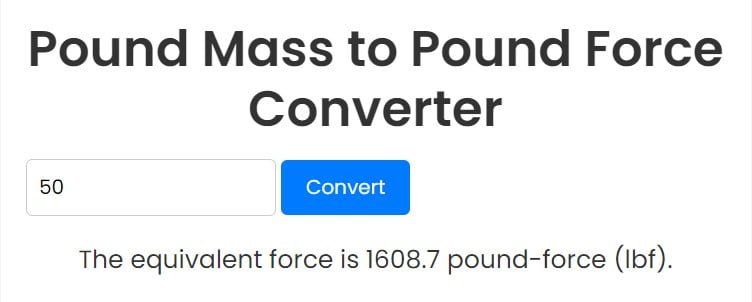Introduction
In the field of physics, as well as engineering, solving math problems frequently requires converting units of measurement from one to another. For instance, unit-for-pound mass to pound force unit conversion comes very commonly. The words – electric power, electrification, and electric bow – may seem similar, yet, they reflect different aspects of physics. In this blog post, we’ll delve into the principles behind these two units of measurement, explore their significance in various fields, and introduce you to a convenient tool: the conversion table must contain the Pound mass to pound force values.
Whether you’re a student, researcher, or professional, this post will provide valuable insights and practical solutions for navigating the complexities of unit conversion. Let’s embark on this journey of understanding together.
Step-by-Step Guide
Converting pound mass to pound force involves simple calculations. Here’s a step-by-step guide:
- Identify the mass in pounds (lbm).
- Enter your mass.
- Click the calculate button and see your result.
Table of Contents
Understanding the Difference
Now that we elucidated the issue, and the difference between pound mass and pound force it is time to discuss the conversion. The pound mass (lbm) is the measure of awful, and pound force (lbf) is the gravity-pulling force, on an object. So, pound mass is your – you can think of it as – pound force is what gravity does to it.
Importance of Conversion
The conversion of pound mass to pound force is a decisive artifact in multiple engineering and scientific spheres. With that in mind, it becomes very simple to work out forces, especially if there are cases when masses need to be counted as forces. The course thus requires the students to solve the puzzles in each discipline, e.g. mechanical engineering, where the mass is the key to the design of structures and mechanisms.
Methods of Conversion
Using the Gravitational Constant
A way of changing the unit of pound mass into pound force is through the gravitational constant. By factoring the mass (lbs) into the acceleration due to gravity (32.174 ft/s²), the weight in pound force can be obtained This method is simple and is easily applied. Many users employ it in diverse usages.
Using Conversion Factors
Another option is using conversion factors to make sure that pound mass and pound force get converted directly from each other. Such factors act as a procedure for deriving the relationship between mass and force, providing a quick and accurate conversion platform, without any complex mathematics.
Conclusion
Thus, conversing pound mass to pound force is a basic idea in physics and engineering. It simplifies calculations and analyses of particular forces. Engineers and scientists gain this distinction between mass and force and so on in their own calculations as conversion methods help in going towards perfection as well as approaching accuracy.
FAQs
- How do you convert pound mass to pound-force? To convert pound mass to pound-force, you can use either of two methods:
- Multiply the pound mass (lbm) by the acceleration due to gravity (32.174 ft/s²).
- Use conversion factors or online converters to get the equivalent pound-force (lbf).
- Is 1 pound the same as 1 pound-force? No, they are not the same. A pound (lb) is a unit of mass, while a pound-force (lbf) is a unit of force. However, in Earth’s gravitational field, 1 pound mass exerts a force of approximately 1 pound-force due to gravity.
- Is 1 lbm equal to 1 lbf? No, 1 lbm (pound mass) is not equal to 1 lbf (pound force). Pound mass measures the amount of matter, while pound force measures the force exerted on that matter due to gravity.
- Is pound a mass or force? The term “pound” can refer to both mass and force, depending on the context. Pound mass (lbm) represents mass, while pound-force (lbf) represents force. It’s essential to distinguish between the two when dealing with calculations and measurements.


